A Comprehensive Report on Procurement Methods in Construction Projects
VerifiedAdded on 2020/03/28
|14
|3329
|156
Report
AI Summary
This report provides a comprehensive analysis of three primary procurement methods used in construction projects: general/traditional contracting, design and construct, and construction management. It begins with an introduction emphasizing the importance of selecting the right procurement approach to meet client objectives and minimize project delays and costs. The report then delves into each method, detailing its characteristics, advantages, and disadvantages. General contracting, the most common method, is explored, highlighting its familiarity, price certainty, and client control, while also acknowledging potential disputes and time consumption. The design and construct approach, where the contractor handles both design and construction, is examined for its single-point responsibility, cost benefits, and time-saving aspects, as well as its limitations in bid comparison and change management. Finally, the construction management approach is discussed, though the provided text is incomplete. The report concludes by emphasizing the need to synchronize client preferences with the appropriate procurement system for successful project outcomes. The report also provides valuable insights into the various features of procurement approaches and their impacts.

Methods of Procurement used In Construction Projects 1
PROCUREMENT METHODS USED IN CONSTRUCTION PROJECTS
Student’s Name
Professor’s Name
Course
Institution
Date
PROCUREMENT METHODS USED IN CONSTRUCTION PROJECTS
Student’s Name
Professor’s Name
Course
Institution
Date
Paraphrase This Document
Need a fresh take? Get an instant paraphrase of this document with our AI Paraphraser
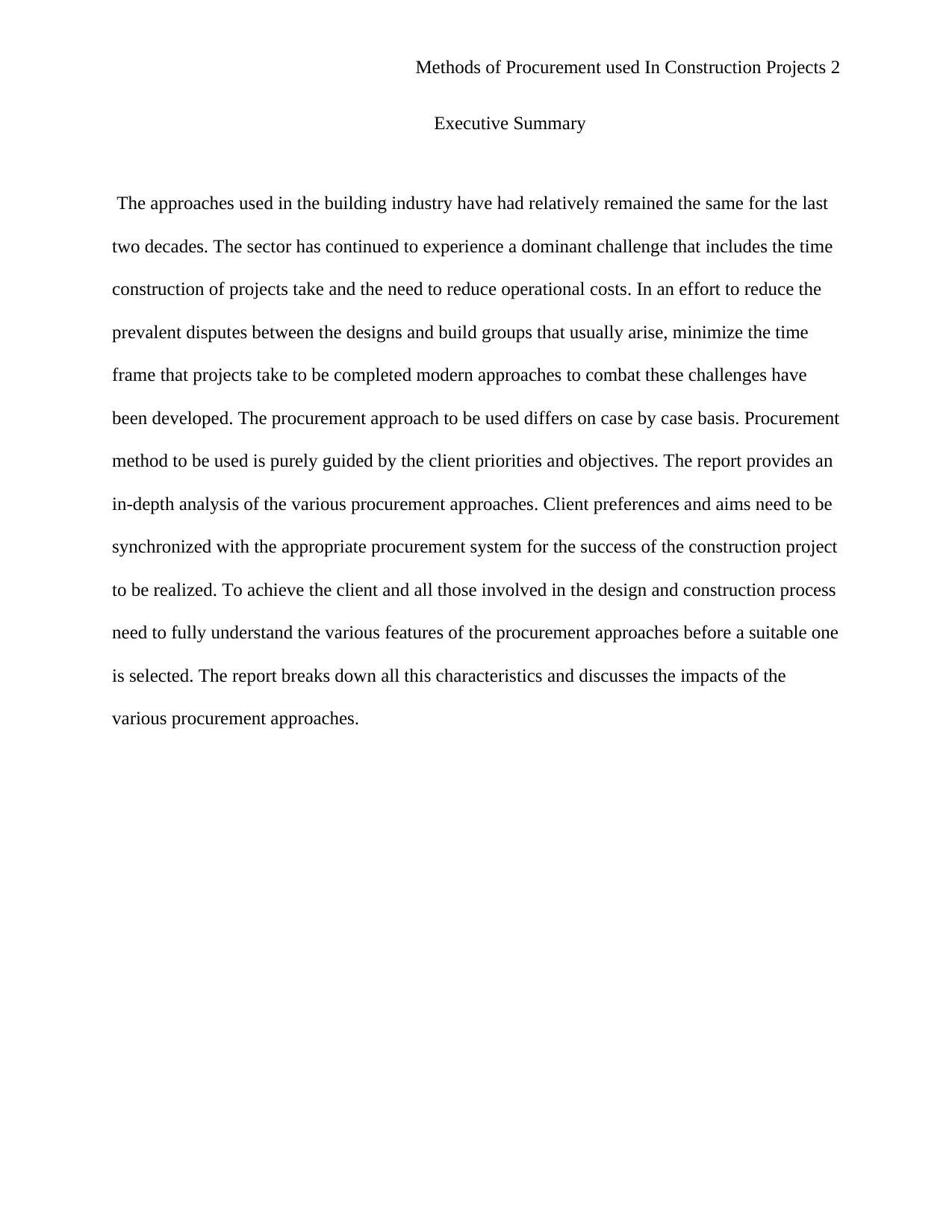
Methods of Procurement used In Construction Projects 2
Executive Summary
The approaches used in the building industry have had relatively remained the same for the last
two decades. The sector has continued to experience a dominant challenge that includes the time
construction of projects take and the need to reduce operational costs. In an effort to reduce the
prevalent disputes between the designs and build groups that usually arise, minimize the time
frame that projects take to be completed modern approaches to combat these challenges have
been developed. The procurement approach to be used differs on case by case basis. Procurement
method to be used is purely guided by the client priorities and objectives. The report provides an
in-depth analysis of the various procurement approaches. Client preferences and aims need to be
synchronized with the appropriate procurement system for the success of the construction project
to be realized. To achieve the client and all those involved in the design and construction process
need to fully understand the various features of the procurement approaches before a suitable one
is selected. The report breaks down all this characteristics and discusses the impacts of the
various procurement approaches.
Executive Summary
The approaches used in the building industry have had relatively remained the same for the last
two decades. The sector has continued to experience a dominant challenge that includes the time
construction of projects take and the need to reduce operational costs. In an effort to reduce the
prevalent disputes between the designs and build groups that usually arise, minimize the time
frame that projects take to be completed modern approaches to combat these challenges have
been developed. The procurement approach to be used differs on case by case basis. Procurement
method to be used is purely guided by the client priorities and objectives. The report provides an
in-depth analysis of the various procurement approaches. Client preferences and aims need to be
synchronized with the appropriate procurement system for the success of the construction project
to be realized. To achieve the client and all those involved in the design and construction process
need to fully understand the various features of the procurement approaches before a suitable one
is selected. The report breaks down all this characteristics and discusses the impacts of the
various procurement approaches.
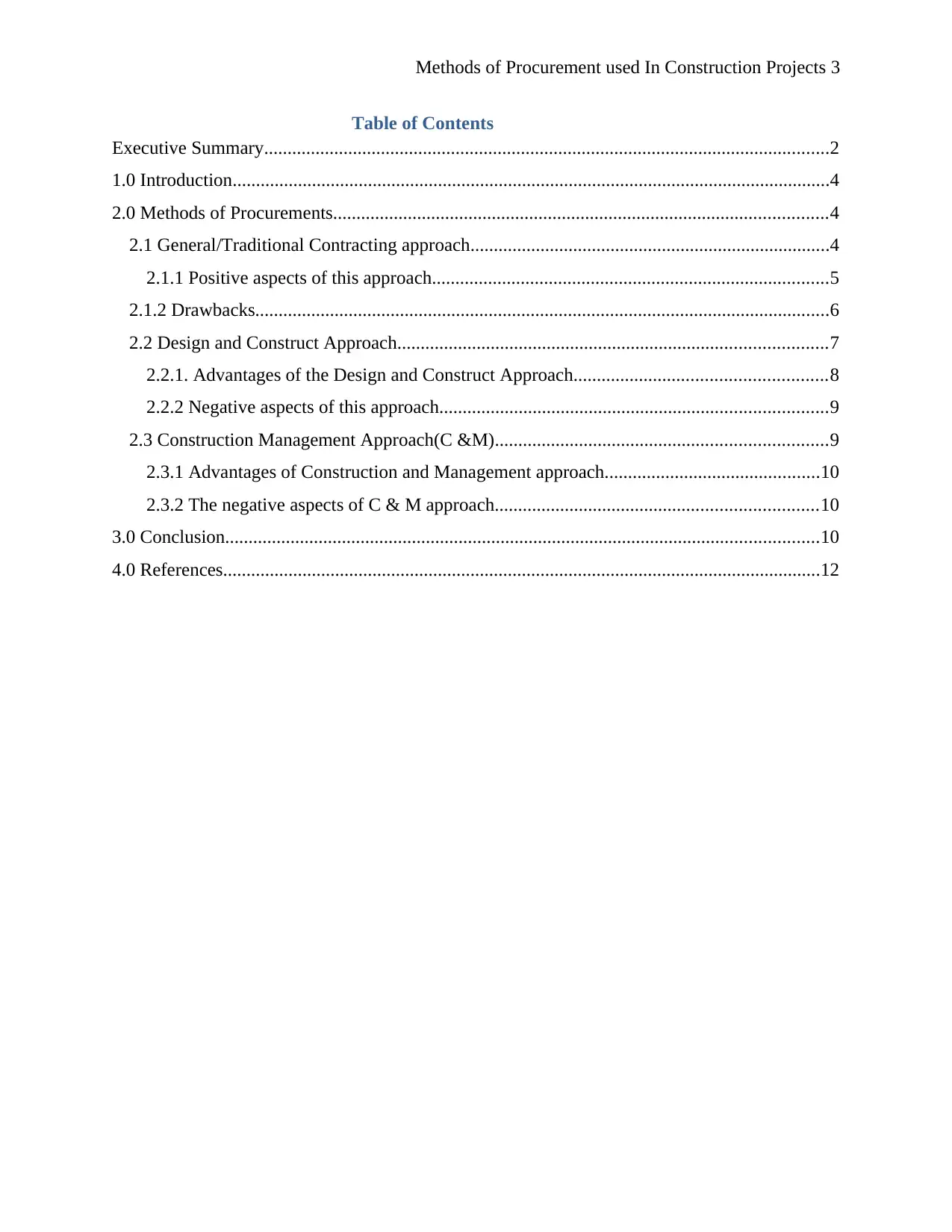
Methods of Procurement used In Construction Projects 3
Table of Contents
Executive Summary.........................................................................................................................2
1.0 Introduction................................................................................................................................4
2.0 Methods of Procurements..........................................................................................................4
2.1 General/Traditional Contracting approach.............................................................................4
2.1.1 Positive aspects of this approach.....................................................................................5
2.1.2 Drawbacks...........................................................................................................................6
2.2 Design and Construct Approach............................................................................................7
2.2.1. Advantages of the Design and Construct Approach......................................................8
2.2.2 Negative aspects of this approach...................................................................................9
2.3 Construction Management Approach(C &M).......................................................................9
2.3.1 Advantages of Construction and Management approach..............................................10
2.3.2 The negative aspects of C & M approach.....................................................................10
3.0 Conclusion...............................................................................................................................10
4.0 References................................................................................................................................12
Table of Contents
Executive Summary.........................................................................................................................2
1.0 Introduction................................................................................................................................4
2.0 Methods of Procurements..........................................................................................................4
2.1 General/Traditional Contracting approach.............................................................................4
2.1.1 Positive aspects of this approach.....................................................................................5
2.1.2 Drawbacks...........................................................................................................................6
2.2 Design and Construct Approach............................................................................................7
2.2.1. Advantages of the Design and Construct Approach......................................................8
2.2.2 Negative aspects of this approach...................................................................................9
2.3 Construction Management Approach(C &M).......................................................................9
2.3.1 Advantages of Construction and Management approach..............................................10
2.3.2 The negative aspects of C & M approach.....................................................................10
3.0 Conclusion...............................................................................................................................10
4.0 References................................................................................................................................12
⊘ This is a preview!⊘
Do you want full access?
Subscribe today to unlock all pages.

Trusted by 1+ million students worldwide
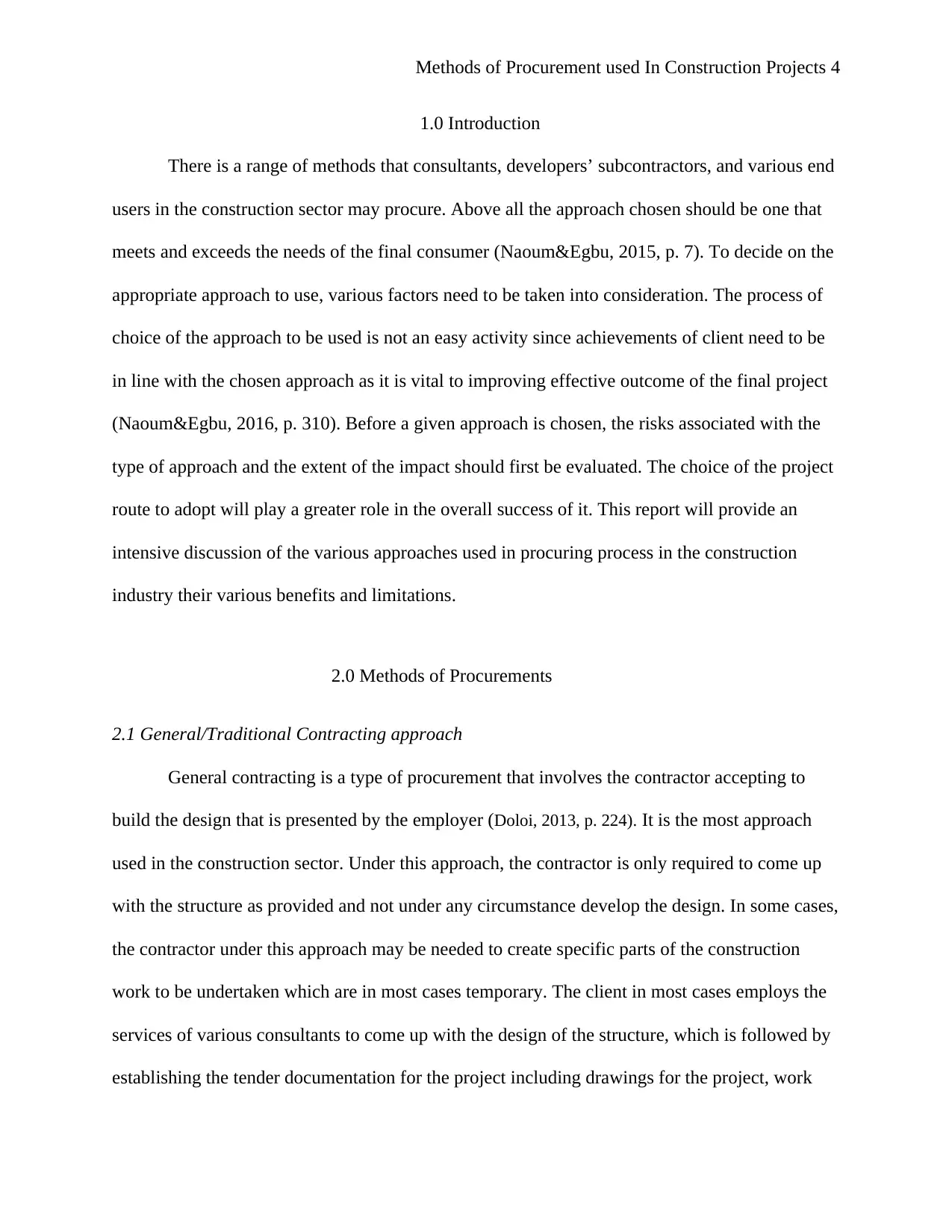
Methods of Procurement used In Construction Projects 4
1.0 Introduction
There is a range of methods that consultants, developers’ subcontractors, and various end
users in the construction sector may procure. Above all the approach chosen should be one that
meets and exceeds the needs of the final consumer (Naoum&Egbu, 2015, p. 7). To decide on the
appropriate approach to use, various factors need to be taken into consideration. The process of
choice of the approach to be used is not an easy activity since achievements of client need to be
in line with the chosen approach as it is vital to improving effective outcome of the final project
(Naoum&Egbu, 2016, p. 310). Before a given approach is chosen, the risks associated with the
type of approach and the extent of the impact should first be evaluated. The choice of the project
route to adopt will play a greater role in the overall success of it. This report will provide an
intensive discussion of the various approaches used in procuring process in the construction
industry their various benefits and limitations.
2.0 Methods of Procurements
2.1 General/Traditional Contracting approach
General contracting is a type of procurement that involves the contractor accepting to
build the design that is presented by the employer (Doloi, 2013, p. 224). It is the most approach
used in the construction sector. Under this approach, the contractor is only required to come up
with the structure as provided and not under any circumstance develop the design. In some cases,
the contractor under this approach may be needed to create specific parts of the construction
work to be undertaken which are in most cases temporary. The client in most cases employs the
services of various consultants to come up with the design of the structure, which is followed by
establishing the tender documentation for the project including drawings for the project, work
1.0 Introduction
There is a range of methods that consultants, developers’ subcontractors, and various end
users in the construction sector may procure. Above all the approach chosen should be one that
meets and exceeds the needs of the final consumer (Naoum&Egbu, 2015, p. 7). To decide on the
appropriate approach to use, various factors need to be taken into consideration. The process of
choice of the approach to be used is not an easy activity since achievements of client need to be
in line with the chosen approach as it is vital to improving effective outcome of the final project
(Naoum&Egbu, 2016, p. 310). Before a given approach is chosen, the risks associated with the
type of approach and the extent of the impact should first be evaluated. The choice of the project
route to adopt will play a greater role in the overall success of it. This report will provide an
intensive discussion of the various approaches used in procuring process in the construction
industry their various benefits and limitations.
2.0 Methods of Procurements
2.1 General/Traditional Contracting approach
General contracting is a type of procurement that involves the contractor accepting to
build the design that is presented by the employer (Doloi, 2013, p. 224). It is the most approach
used in the construction sector. Under this approach, the contractor is only required to come up
with the structure as provided and not under any circumstance develop the design. In some cases,
the contractor under this approach may be needed to create specific parts of the construction
work to be undertaken which are in most cases temporary. The client in most cases employs the
services of various consultants to come up with the design of the structure, which is followed by
establishing the tender documentation for the project including drawings for the project, work
Paraphrase This Document
Need a fresh take? Get an instant paraphrase of this document with our AI Paraphraser
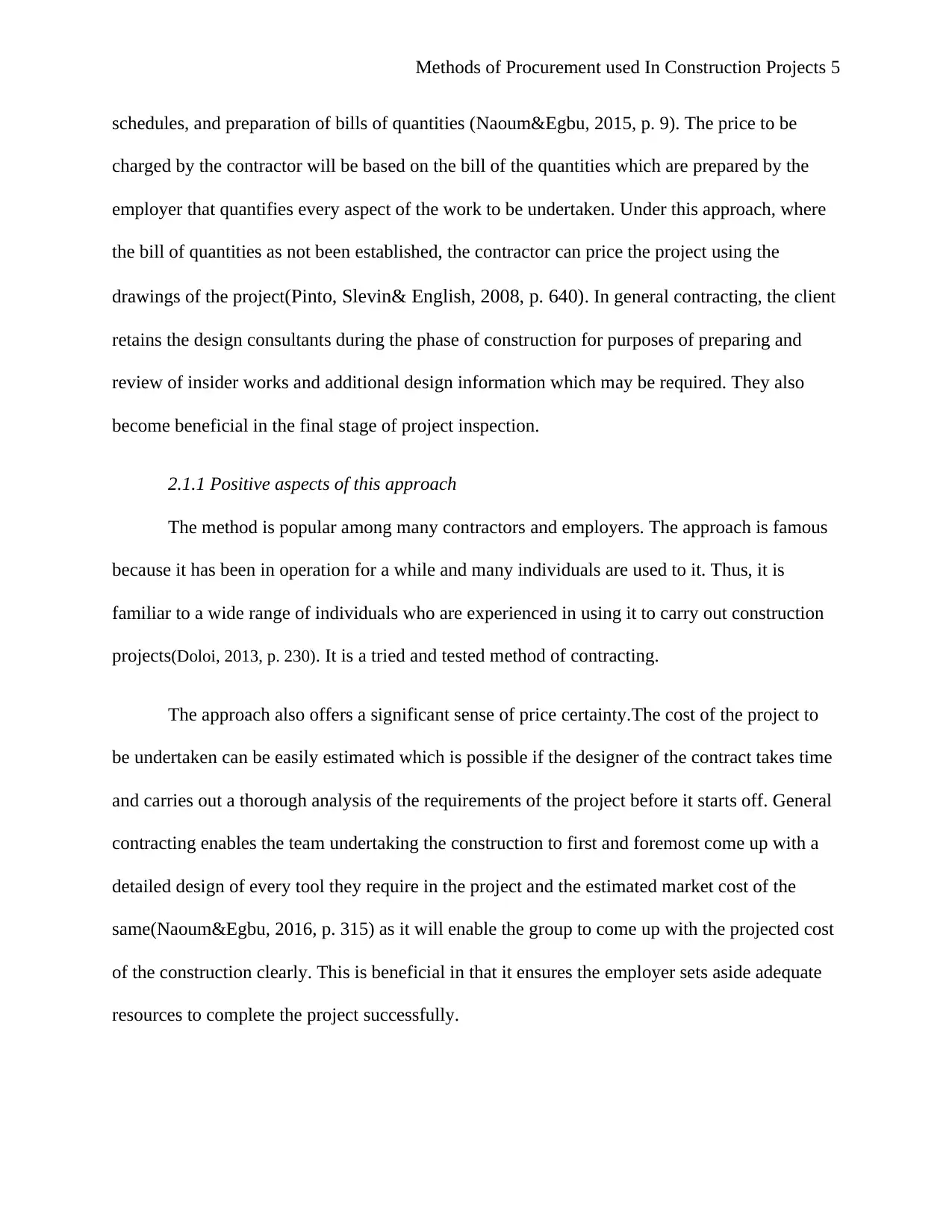
Methods of Procurement used In Construction Projects 5
schedules, and preparation of bills of quantities (Naoum&Egbu, 2015, p. 9). The price to be
charged by the contractor will be based on the bill of the quantities which are prepared by the
employer that quantifies every aspect of the work to be undertaken. Under this approach, where
the bill of quantities as not been established, the contractor can price the project using the
drawings of the project(Pinto, Slevin& English, 2008, p. 640). In general contracting, the client
retains the design consultants during the phase of construction for purposes of preparing and
review of insider works and additional design information which may be required. They also
become beneficial in the final stage of project inspection.
2.1.1 Positive aspects of this approach
The method is popular among many contractors and employers. The approach is famous
because it has been in operation for a while and many individuals are used to it. Thus, it is
familiar to a wide range of individuals who are experienced in using it to carry out construction
projects(Doloi, 2013, p. 230). It is a tried and tested method of contracting.
The approach also offers a significant sense of price certainty.The cost of the project to
be undertaken can be easily estimated which is possible if the designer of the contract takes time
and carries out a thorough analysis of the requirements of the project before it starts off. General
contracting enables the team undertaking the construction to first and foremost come up with a
detailed design of every tool they require in the project and the estimated market cost of the
same(Naoum&Egbu, 2016, p. 315) as it will enable the group to come up with the projected cost
of the construction clearly. This is beneficial in that it ensures the employer sets aside adequate
resources to complete the project successfully.
schedules, and preparation of bills of quantities (Naoum&Egbu, 2015, p. 9). The price to be
charged by the contractor will be based on the bill of the quantities which are prepared by the
employer that quantifies every aspect of the work to be undertaken. Under this approach, where
the bill of quantities as not been established, the contractor can price the project using the
drawings of the project(Pinto, Slevin& English, 2008, p. 640). In general contracting, the client
retains the design consultants during the phase of construction for purposes of preparing and
review of insider works and additional design information which may be required. They also
become beneficial in the final stage of project inspection.
2.1.1 Positive aspects of this approach
The method is popular among many contractors and employers. The approach is famous
because it has been in operation for a while and many individuals are used to it. Thus, it is
familiar to a wide range of individuals who are experienced in using it to carry out construction
projects(Doloi, 2013, p. 230). It is a tried and tested method of contracting.
The approach also offers a significant sense of price certainty.The cost of the project to
be undertaken can be easily estimated which is possible if the designer of the contract takes time
and carries out a thorough analysis of the requirements of the project before it starts off. General
contracting enables the team undertaking the construction to first and foremost come up with a
detailed design of every tool they require in the project and the estimated market cost of the
same(Naoum&Egbu, 2016, p. 315) as it will enable the group to come up with the projected cost
of the construction clearly. This is beneficial in that it ensures the employer sets aside adequate
resources to complete the project successfully.
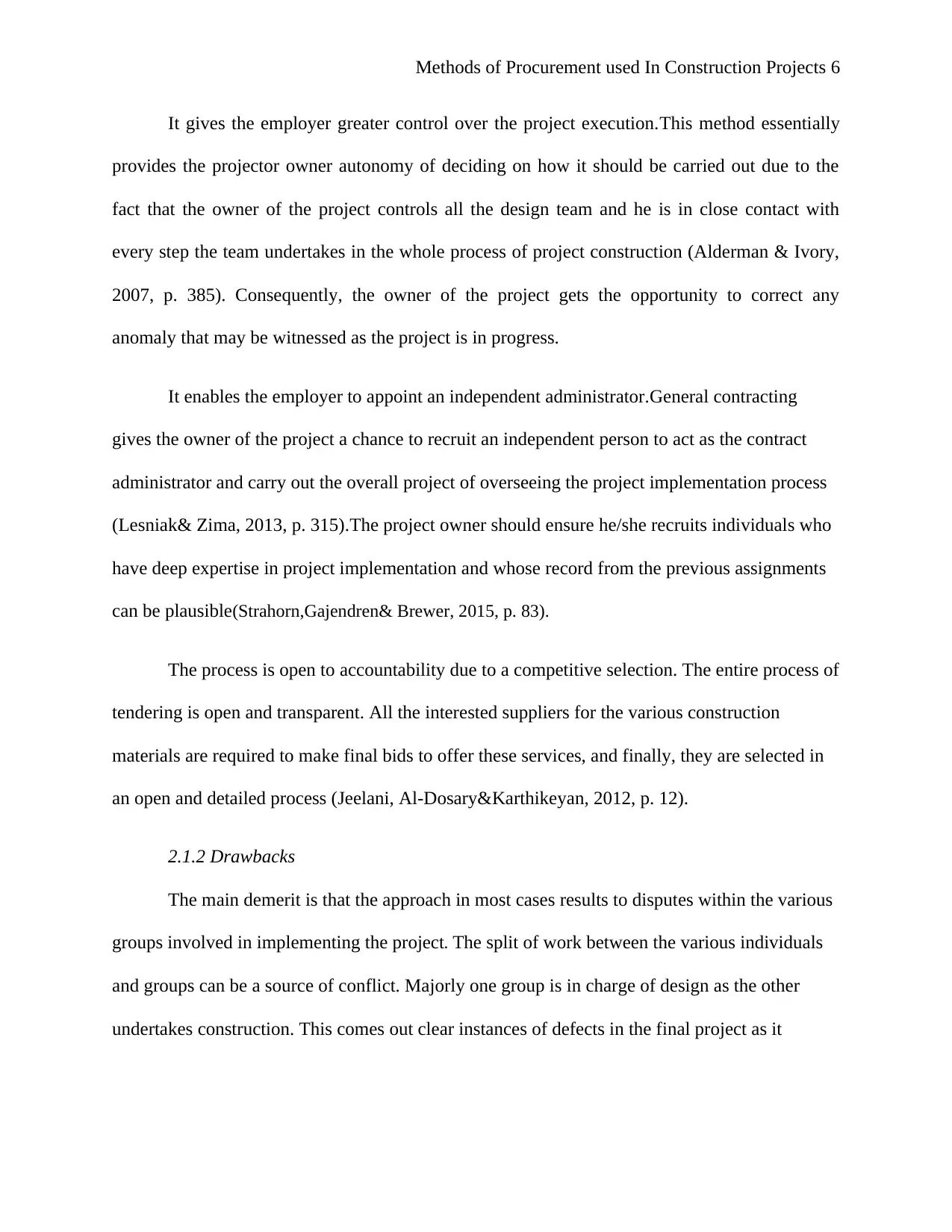
Methods of Procurement used In Construction Projects 6
It gives the employer greater control over the project execution.This method essentially
provides the projector owner autonomy of deciding on how it should be carried out due to the
fact that the owner of the project controls all the design team and he is in close contact with
every step the team undertakes in the whole process of project construction (Alderman & Ivory,
2007, p. 385). Consequently, the owner of the project gets the opportunity to correct any
anomaly that may be witnessed as the project is in progress.
It enables the employer to appoint an independent administrator.General contracting
gives the owner of the project a chance to recruit an independent person to act as the contract
administrator and carry out the overall project of overseeing the project implementation process
(Lesniak& Zima, 2013, p. 315).The project owner should ensure he/she recruits individuals who
have deep expertise in project implementation and whose record from the previous assignments
can be plausible(Strahorn,Gajendren& Brewer, 2015, p. 83).
The process is open to accountability due to a competitive selection. The entire process of
tendering is open and transparent. All the interested suppliers for the various construction
materials are required to make final bids to offer these services, and finally, they are selected in
an open and detailed process (Jeelani, Al-Dosary&Karthikeyan, 2012, p. 12).
2.1.2 Drawbacks
The main demerit is that the approach in most cases results to disputes within the various
groups involved in implementing the project. The split of work between the various individuals
and groups can be a source of conflict. Majorly one group is in charge of design as the other
undertakes construction. This comes out clear instances of defects in the final project as it
It gives the employer greater control over the project execution.This method essentially
provides the projector owner autonomy of deciding on how it should be carried out due to the
fact that the owner of the project controls all the design team and he is in close contact with
every step the team undertakes in the whole process of project construction (Alderman & Ivory,
2007, p. 385). Consequently, the owner of the project gets the opportunity to correct any
anomaly that may be witnessed as the project is in progress.
It enables the employer to appoint an independent administrator.General contracting
gives the owner of the project a chance to recruit an independent person to act as the contract
administrator and carry out the overall project of overseeing the project implementation process
(Lesniak& Zima, 2013, p. 315).The project owner should ensure he/she recruits individuals who
have deep expertise in project implementation and whose record from the previous assignments
can be plausible(Strahorn,Gajendren& Brewer, 2015, p. 83).
The process is open to accountability due to a competitive selection. The entire process of
tendering is open and transparent. All the interested suppliers for the various construction
materials are required to make final bids to offer these services, and finally, they are selected in
an open and detailed process (Jeelani, Al-Dosary&Karthikeyan, 2012, p. 12).
2.1.2 Drawbacks
The main demerit is that the approach in most cases results to disputes within the various
groups involved in implementing the project. The split of work between the various individuals
and groups can be a source of conflict. Majorly one group is in charge of design as the other
undertakes construction. This comes out clear instances of defects in the final project as it
⊘ This is a preview!⊘
Do you want full access?
Subscribe today to unlock all pages.

Trusted by 1+ million students worldwide
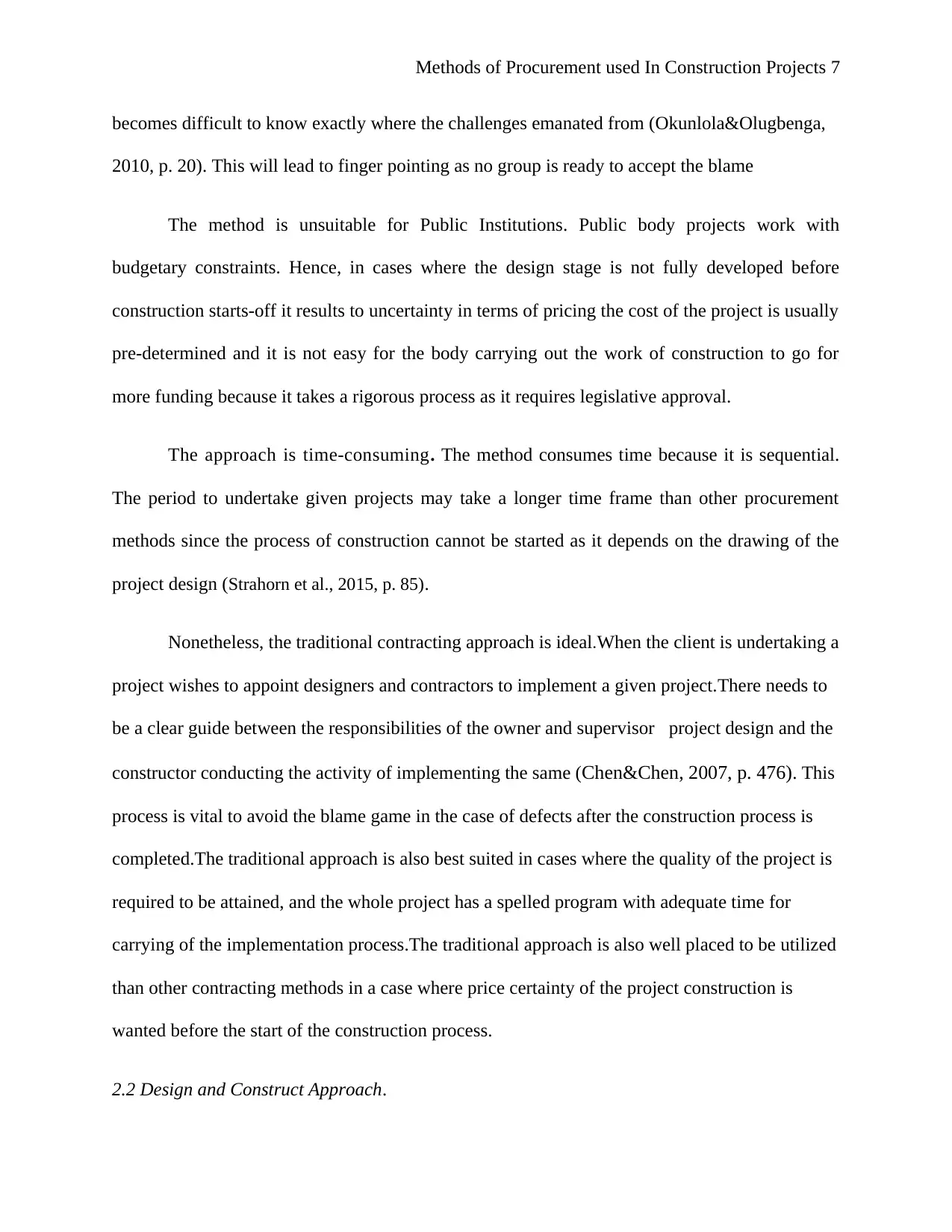
Methods of Procurement used In Construction Projects 7
becomes difficult to know exactly where the challenges emanated from (Okunlola&Olugbenga,
2010, p. 20). This will lead to finger pointing as no group is ready to accept the blame
The method is unsuitable for Public Institutions. Public body projects work with
budgetary constraints. Hence, in cases where the design stage is not fully developed before
construction starts-off it results to uncertainty in terms of pricing the cost of the project is usually
pre-determined and it is not easy for the body carrying out the work of construction to go for
more funding because it takes a rigorous process as it requires legislative approval.
The approach is time-consuming. The method consumes time because it is sequential.
The period to undertake given projects may take a longer time frame than other procurement
methods since the process of construction cannot be started as it depends on the drawing of the
project design (Strahorn et al., 2015, p. 85).
Nonetheless, the traditional contracting approach is ideal.When the client is undertaking a
project wishes to appoint designers and contractors to implement a given project.There needs to
be a clear guide between the responsibilities of the owner and supervisor project design and the
constructor conducting the activity of implementing the same (Chen&Chen, 2007, p. 476). This
process is vital to avoid the blame game in the case of defects after the construction process is
completed.The traditional approach is also best suited in cases where the quality of the project is
required to be attained, and the whole project has a spelled program with adequate time for
carrying of the implementation process.The traditional approach is also well placed to be utilized
than other contracting methods in a case where price certainty of the project construction is
wanted before the start of the construction process.
2.2 Design and Construct Approach.
becomes difficult to know exactly where the challenges emanated from (Okunlola&Olugbenga,
2010, p. 20). This will lead to finger pointing as no group is ready to accept the blame
The method is unsuitable for Public Institutions. Public body projects work with
budgetary constraints. Hence, in cases where the design stage is not fully developed before
construction starts-off it results to uncertainty in terms of pricing the cost of the project is usually
pre-determined and it is not easy for the body carrying out the work of construction to go for
more funding because it takes a rigorous process as it requires legislative approval.
The approach is time-consuming. The method consumes time because it is sequential.
The period to undertake given projects may take a longer time frame than other procurement
methods since the process of construction cannot be started as it depends on the drawing of the
project design (Strahorn et al., 2015, p. 85).
Nonetheless, the traditional contracting approach is ideal.When the client is undertaking a
project wishes to appoint designers and contractors to implement a given project.There needs to
be a clear guide between the responsibilities of the owner and supervisor project design and the
constructor conducting the activity of implementing the same (Chen&Chen, 2007, p. 476). This
process is vital to avoid the blame game in the case of defects after the construction process is
completed.The traditional approach is also best suited in cases where the quality of the project is
required to be attained, and the whole project has a spelled program with adequate time for
carrying of the implementation process.The traditional approach is also well placed to be utilized
than other contracting methods in a case where price certainty of the project construction is
wanted before the start of the construction process.
2.2 Design and Construct Approach.
Paraphrase This Document
Need a fresh take? Get an instant paraphrase of this document with our AI Paraphraser
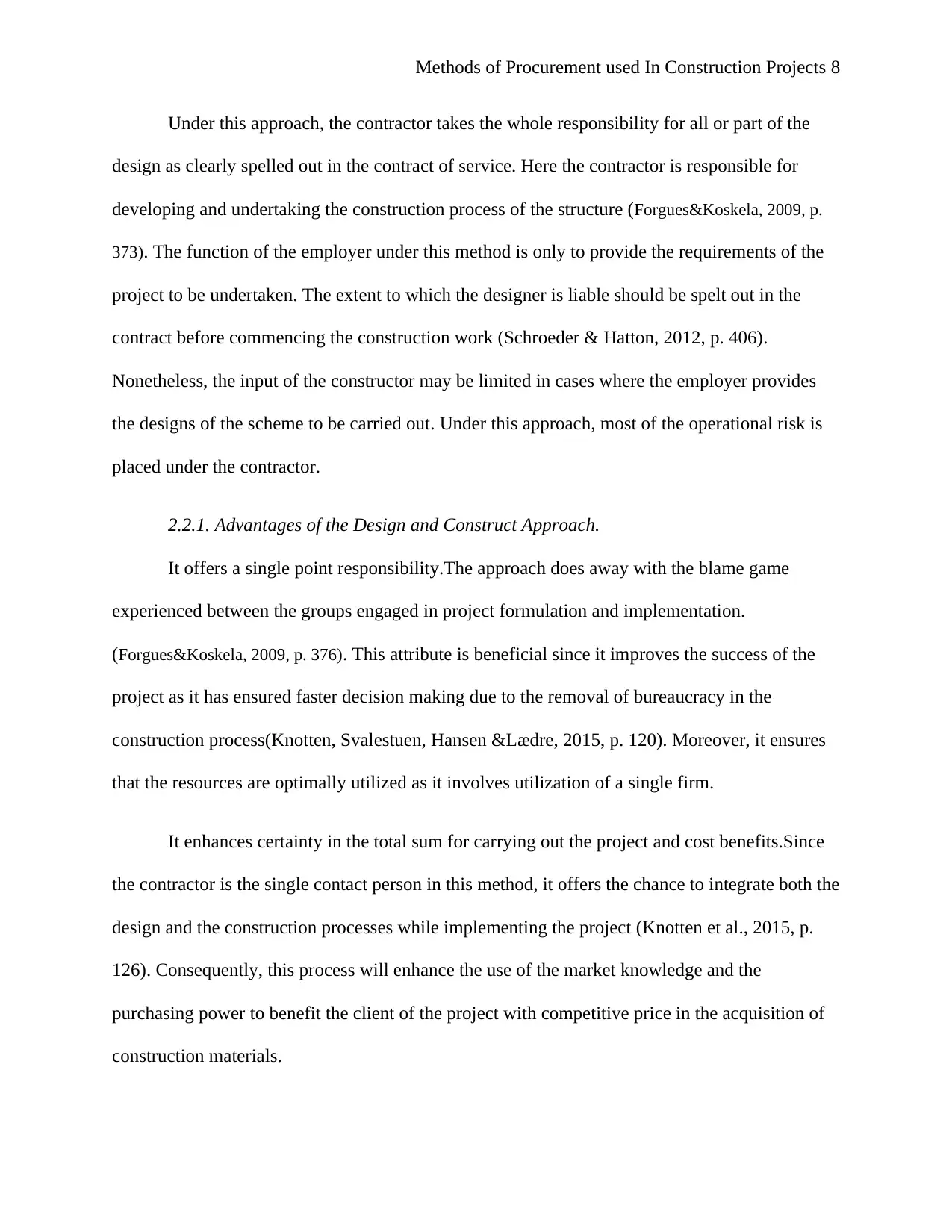
Methods of Procurement used In Construction Projects 8
Under this approach, the contractor takes the whole responsibility for all or part of the
design as clearly spelled out in the contract of service. Here the contractor is responsible for
developing and undertaking the construction process of the structure (Forgues&Koskela, 2009, p.
373). The function of the employer under this method is only to provide the requirements of the
project to be undertaken. The extent to which the designer is liable should be spelt out in the
contract before commencing the construction work (Schroeder & Hatton, 2012, p. 406).
Nonetheless, the input of the constructor may be limited in cases where the employer provides
the designs of the scheme to be carried out. Under this approach, most of the operational risk is
placed under the contractor.
2.2.1. Advantages of the Design and Construct Approach.
It offers a single point responsibility.The approach does away with the blame game
experienced between the groups engaged in project formulation and implementation.
(Forgues&Koskela, 2009, p. 376). This attribute is beneficial since it improves the success of the
project as it has ensured faster decision making due to the removal of bureaucracy in the
construction process(Knotten, Svalestuen, Hansen &Lædre, 2015, p. 120). Moreover, it ensures
that the resources are optimally utilized as it involves utilization of a single firm.
It enhances certainty in the total sum for carrying out the project and cost benefits.Since
the contractor is the single contact person in this method, it offers the chance to integrate both the
design and the construction processes while implementing the project (Knotten et al., 2015, p.
126). Consequently, this process will enhance the use of the market knowledge and the
purchasing power to benefit the client of the project with competitive price in the acquisition of
construction materials.
Under this approach, the contractor takes the whole responsibility for all or part of the
design as clearly spelled out in the contract of service. Here the contractor is responsible for
developing and undertaking the construction process of the structure (Forgues&Koskela, 2009, p.
373). The function of the employer under this method is only to provide the requirements of the
project to be undertaken. The extent to which the designer is liable should be spelt out in the
contract before commencing the construction work (Schroeder & Hatton, 2012, p. 406).
Nonetheless, the input of the constructor may be limited in cases where the employer provides
the designs of the scheme to be carried out. Under this approach, most of the operational risk is
placed under the contractor.
2.2.1. Advantages of the Design and Construct Approach.
It offers a single point responsibility.The approach does away with the blame game
experienced between the groups engaged in project formulation and implementation.
(Forgues&Koskela, 2009, p. 376). This attribute is beneficial since it improves the success of the
project as it has ensured faster decision making due to the removal of bureaucracy in the
construction process(Knotten, Svalestuen, Hansen &Lædre, 2015, p. 120). Moreover, it ensures
that the resources are optimally utilized as it involves utilization of a single firm.
It enhances certainty in the total sum for carrying out the project and cost benefits.Since
the contractor is the single contact person in this method, it offers the chance to integrate both the
design and the construction processes while implementing the project (Knotten et al., 2015, p.
126). Consequently, this process will enhance the use of the market knowledge and the
purchasing power to benefit the client of the project with competitive price in the acquisition of
construction materials.
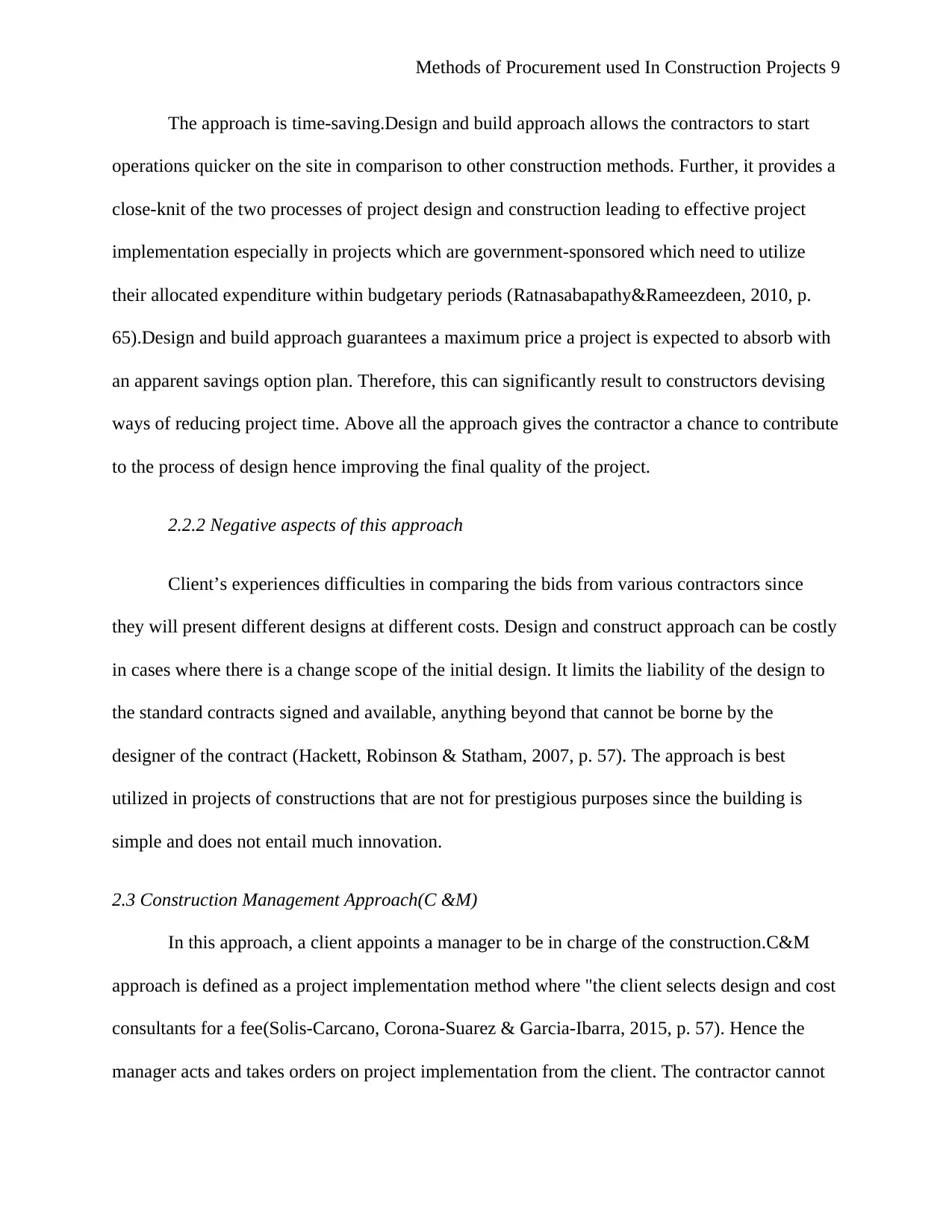
Methods of Procurement used In Construction Projects 9
The approach is time-saving.Design and build approach allows the contractors to start
operations quicker on the site in comparison to other construction methods. Further, it provides a
close-knit of the two processes of project design and construction leading to effective project
implementation especially in projects which are government-sponsored which need to utilize
their allocated expenditure within budgetary periods (Ratnasabapathy&Rameezdeen, 2010, p.
65).Design and build approach guarantees a maximum price a project is expected to absorb with
an apparent savings option plan. Therefore, this can significantly result to constructors devising
ways of reducing project time. Above all the approach gives the contractor a chance to contribute
to the process of design hence improving the final quality of the project.
2.2.2 Negative aspects of this approach
Client’s experiences difficulties in comparing the bids from various contractors since
they will present different designs at different costs. Design and construct approach can be costly
in cases where there is a change scope of the initial design. It limits the liability of the design to
the standard contracts signed and available, anything beyond that cannot be borne by the
designer of the contract (Hackett, Robinson & Statham, 2007, p. 57). The approach is best
utilized in projects of constructions that are not for prestigious purposes since the building is
simple and does not entail much innovation.
2.3 Construction Management Approach(C &M)
In this approach, a client appoints a manager to be in charge of the construction.C&M
approach is defined as a project implementation method where "the client selects design and cost
consultants for a fee(Solis-Carcano, Corona-Suarez & Garcia-Ibarra, 2015, p. 57). Hence the
manager acts and takes orders on project implementation from the client. The contractor cannot
The approach is time-saving.Design and build approach allows the contractors to start
operations quicker on the site in comparison to other construction methods. Further, it provides a
close-knit of the two processes of project design and construction leading to effective project
implementation especially in projects which are government-sponsored which need to utilize
their allocated expenditure within budgetary periods (Ratnasabapathy&Rameezdeen, 2010, p.
65).Design and build approach guarantees a maximum price a project is expected to absorb with
an apparent savings option plan. Therefore, this can significantly result to constructors devising
ways of reducing project time. Above all the approach gives the contractor a chance to contribute
to the process of design hence improving the final quality of the project.
2.2.2 Negative aspects of this approach
Client’s experiences difficulties in comparing the bids from various contractors since
they will present different designs at different costs. Design and construct approach can be costly
in cases where there is a change scope of the initial design. It limits the liability of the design to
the standard contracts signed and available, anything beyond that cannot be borne by the
designer of the contract (Hackett, Robinson & Statham, 2007, p. 57). The approach is best
utilized in projects of constructions that are not for prestigious purposes since the building is
simple and does not entail much innovation.
2.3 Construction Management Approach(C &M)
In this approach, a client appoints a manager to be in charge of the construction.C&M
approach is defined as a project implementation method where "the client selects design and cost
consultants for a fee(Solis-Carcano, Corona-Suarez & Garcia-Ibarra, 2015, p. 57). Hence the
manager acts and takes orders on project implementation from the client. The contractor cannot
⊘ This is a preview!⊘
Do you want full access?
Subscribe today to unlock all pages.

Trusted by 1+ million students worldwide
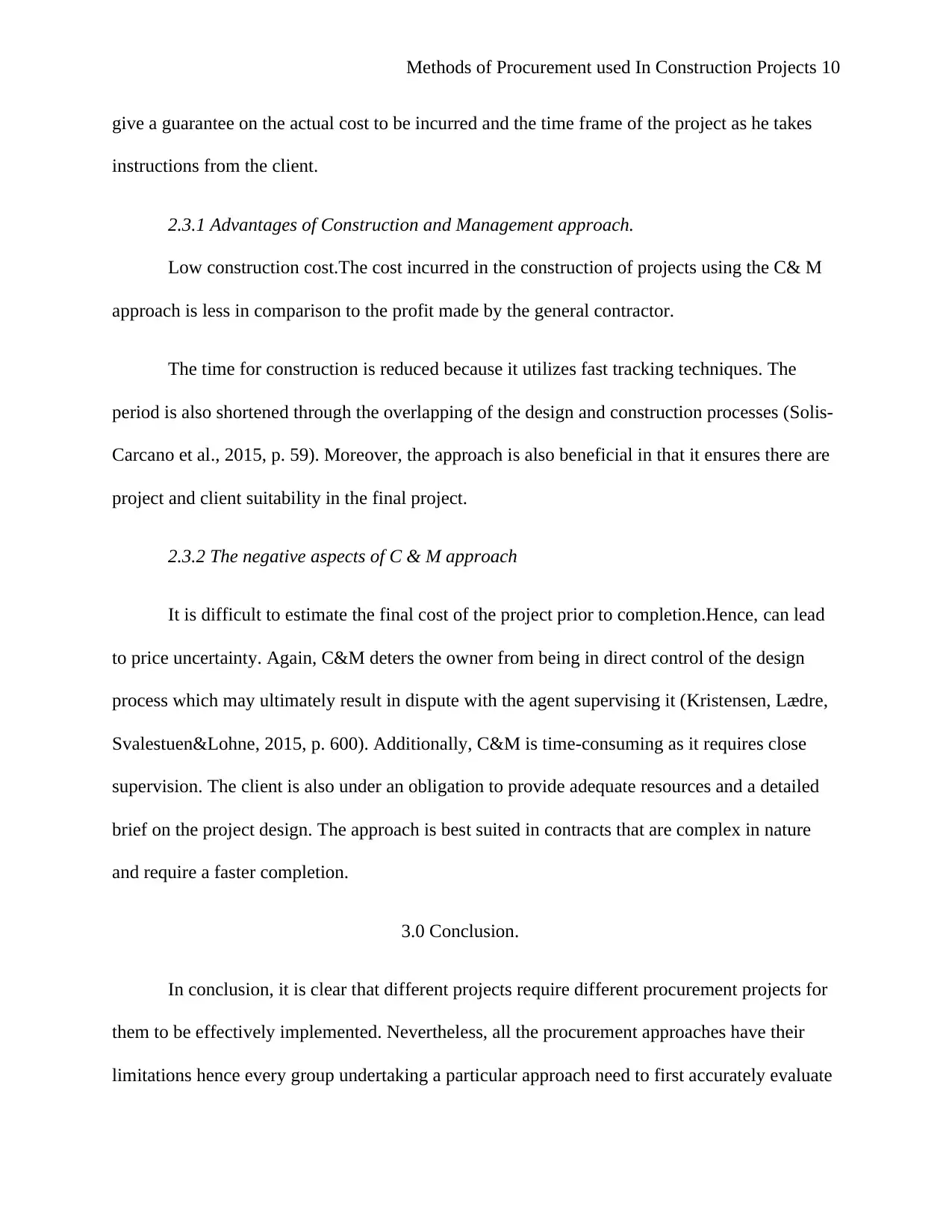
Methods of Procurement used In Construction Projects 10
give a guarantee on the actual cost to be incurred and the time frame of the project as he takes
instructions from the client.
2.3.1 Advantages of Construction and Management approach.
Low construction cost.The cost incurred in the construction of projects using the C& M
approach is less in comparison to the profit made by the general contractor.
The time for construction is reduced because it utilizes fast tracking techniques. The
period is also shortened through the overlapping of the design and construction processes (Solis-
Carcano et al., 2015, p. 59). Moreover, the approach is also beneficial in that it ensures there are
project and client suitability in the final project.
2.3.2 The negative aspects of C & M approach
It is difficult to estimate the final cost of the project prior to completion.Hence, can lead
to price uncertainty. Again, C&M deters the owner from being in direct control of the design
process which may ultimately result in dispute with the agent supervising it (Kristensen, Lædre,
Svalestuen&Lohne, 2015, p. 600). Additionally, C&M is time-consuming as it requires close
supervision. The client is also under an obligation to provide adequate resources and a detailed
brief on the project design. The approach is best suited in contracts that are complex in nature
and require a faster completion.
3.0 Conclusion.
In conclusion, it is clear that different projects require different procurement projects for
them to be effectively implemented. Nevertheless, all the procurement approaches have their
limitations hence every group undertaking a particular approach need to first accurately evaluate
give a guarantee on the actual cost to be incurred and the time frame of the project as he takes
instructions from the client.
2.3.1 Advantages of Construction and Management approach.
Low construction cost.The cost incurred in the construction of projects using the C& M
approach is less in comparison to the profit made by the general contractor.
The time for construction is reduced because it utilizes fast tracking techniques. The
period is also shortened through the overlapping of the design and construction processes (Solis-
Carcano et al., 2015, p. 59). Moreover, the approach is also beneficial in that it ensures there are
project and client suitability in the final project.
2.3.2 The negative aspects of C & M approach
It is difficult to estimate the final cost of the project prior to completion.Hence, can lead
to price uncertainty. Again, C&M deters the owner from being in direct control of the design
process which may ultimately result in dispute with the agent supervising it (Kristensen, Lædre,
Svalestuen&Lohne, 2015, p. 600). Additionally, C&M is time-consuming as it requires close
supervision. The client is also under an obligation to provide adequate resources and a detailed
brief on the project design. The approach is best suited in contracts that are complex in nature
and require a faster completion.
3.0 Conclusion.
In conclusion, it is clear that different projects require different procurement projects for
them to be effectively implemented. Nevertheless, all the procurement approaches have their
limitations hence every group undertaking a particular approach need to first accurately evaluate
Paraphrase This Document
Need a fresh take? Get an instant paraphrase of this document with our AI Paraphraser

Methods of Procurement used In Construction Projects 11
their requirements and address the same for the projects to be successful. A comprehensive
evaluation will provide the ground for applying the most suited method that will ensure the
organization or clients accomplishes the ultimate aims.
their requirements and address the same for the projects to be successful. A comprehensive
evaluation will provide the ground for applying the most suited method that will ensure the
organization or clients accomplishes the ultimate aims.
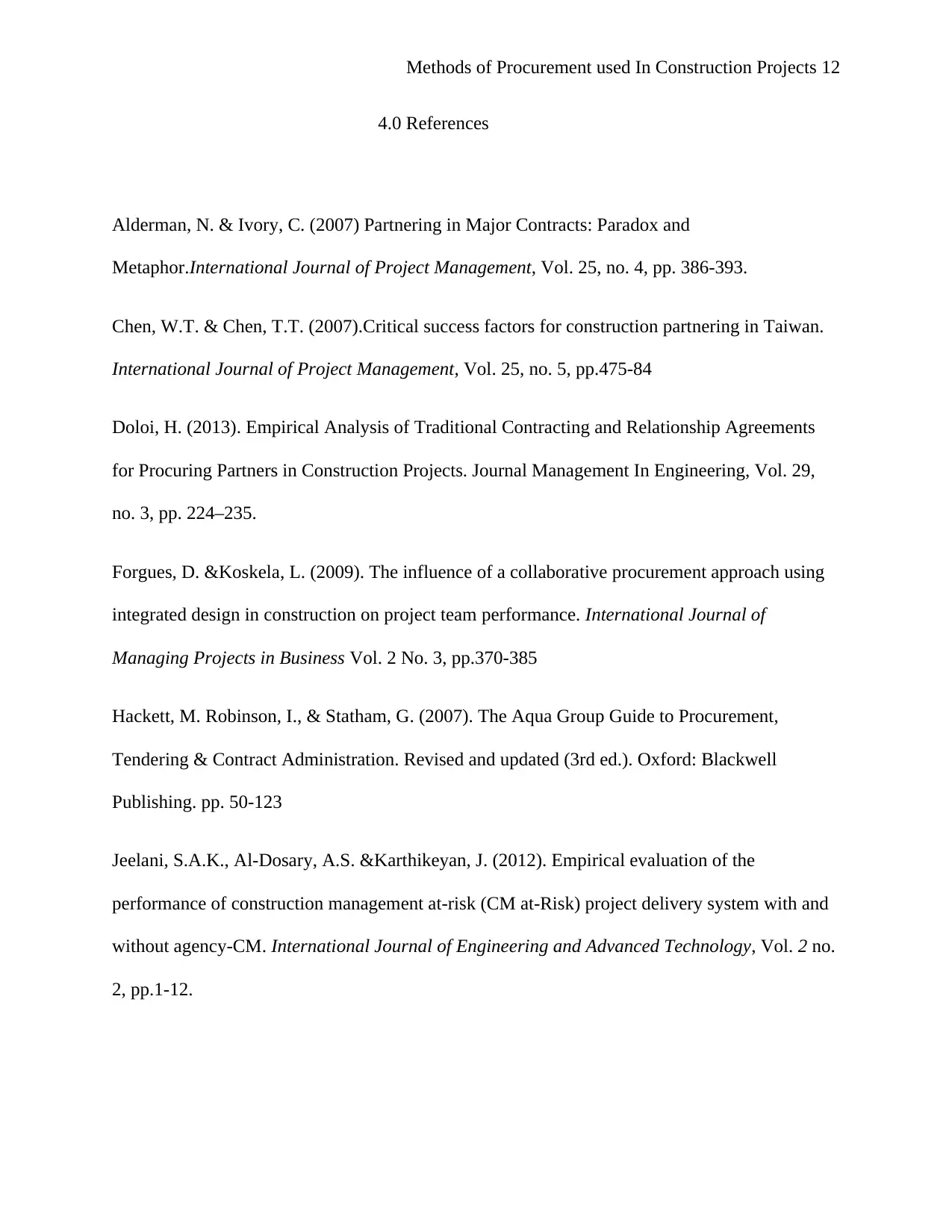
Methods of Procurement used In Construction Projects 12
4.0 References
Alderman, N. & Ivory, C. (2007) Partnering in Major Contracts: Paradox and
Metaphor.International Journal of Project Management, Vol. 25, no. 4, pp. 386-393.
Chen, W.T. & Chen, T.T. (2007).Critical success factors for construction partnering in Taiwan.
International Journal of Project Management, Vol. 25, no. 5, pp.475-84
Doloi, H. (2013). Empirical Analysis of Traditional Contracting and Relationship Agreements
for Procuring Partners in Construction Projects. Journal Management In Engineering, Vol. 29,
no. 3, pp. 224–235.
Forgues, D. &Koskela, L. (2009). The influence of a collaborative procurement approach using
integrated design in construction on project team performance. International Journal of
Managing Projects in Business Vol. 2 No. 3, pp.370-385
Hackett, M. Robinson, I., & Statham, G. (2007). The Aqua Group Guide to Procurement,
Tendering & Contract Administration. Revised and updated (3rd ed.). Oxford: Blackwell
Publishing. pp. 50-123
Jeelani, S.A.K., Al-Dosary, A.S. &Karthikeyan, J. (2012). Empirical evaluation of the
performance of construction management at-risk (CM at-Risk) project delivery system with and
without agency-CM. International Journal of Engineering and Advanced Technology, Vol. 2 no.
2, pp.1-12.
4.0 References
Alderman, N. & Ivory, C. (2007) Partnering in Major Contracts: Paradox and
Metaphor.International Journal of Project Management, Vol. 25, no. 4, pp. 386-393.
Chen, W.T. & Chen, T.T. (2007).Critical success factors for construction partnering in Taiwan.
International Journal of Project Management, Vol. 25, no. 5, pp.475-84
Doloi, H. (2013). Empirical Analysis of Traditional Contracting and Relationship Agreements
for Procuring Partners in Construction Projects. Journal Management In Engineering, Vol. 29,
no. 3, pp. 224–235.
Forgues, D. &Koskela, L. (2009). The influence of a collaborative procurement approach using
integrated design in construction on project team performance. International Journal of
Managing Projects in Business Vol. 2 No. 3, pp.370-385
Hackett, M. Robinson, I., & Statham, G. (2007). The Aqua Group Guide to Procurement,
Tendering & Contract Administration. Revised and updated (3rd ed.). Oxford: Blackwell
Publishing. pp. 50-123
Jeelani, S.A.K., Al-Dosary, A.S. &Karthikeyan, J. (2012). Empirical evaluation of the
performance of construction management at-risk (CM at-Risk) project delivery system with and
without agency-CM. International Journal of Engineering and Advanced Technology, Vol. 2 no.
2, pp.1-12.
⊘ This is a preview!⊘
Do you want full access?
Subscribe today to unlock all pages.

Trusted by 1+ million students worldwide
1 out of 14
Related Documents
Your All-in-One AI-Powered Toolkit for Academic Success.
+13062052269
info@desklib.com
Available 24*7 on WhatsApp / Email
![[object Object]](/_next/static/media/star-bottom.7253800d.svg)
Unlock your academic potential
Copyright © 2020–2025 A2Z Services. All Rights Reserved. Developed and managed by ZUCOL.





